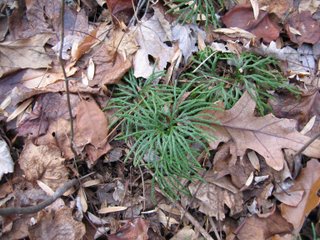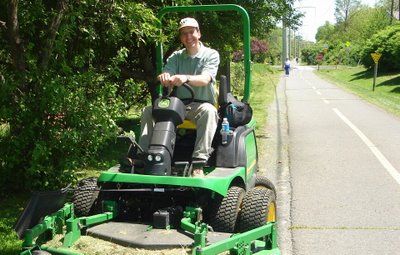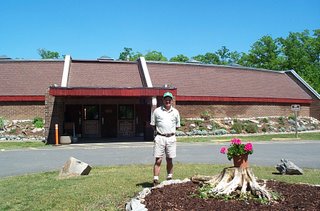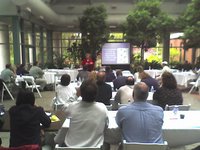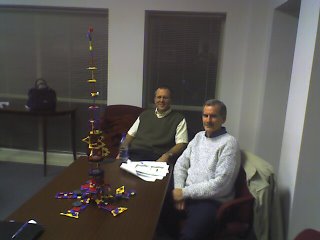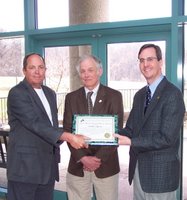
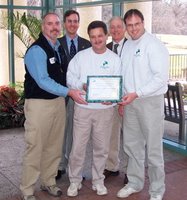
For the first time the Regional Park Authority gave performance awards for our many heros that make NVRPA such a great organization. The awardees were nominated by their peers, and selected by a cross functional team of employees. These great public servants demonstrated innovation, team work, dedication and great 'can do' attitudes.
Jim Bartlinski
In the categories of Above-and-Beyond, Cost Saving and Programming, for the low-cost development of an innovative program interpreting death rituals of the 18th century entitled Death Comes to Carlyle House, and for generating a tremendous amount of publicity for NVRPA by staging a mock funeral procession for John Carlyle as part of the interpretive program.
Gary Becht
In the category of Innovation, for the establishment of a program to save manpower through the use of more efficient and modern maintenance equipment and reductions in mowing areas. The plan also resulted in expanded and improved wildlife habitat areas at Meadowlark Botanical Gardens.
Todd Benson
In the categories of Above-and-Beyond, Innovation and Team Player, for developing new marketing programs and protocols at Algonkian and Cameron Run, assisting with the cross-promotion of various facilities throughout NVRPA, and an outstanding “can-do” attitude.
Tony Blevins
In the category of Versatility, for generating outstanding golf course improvement ideas, working day or night whenever necessary, and fostering good morale and team work among his employees.
Claire Blanchard
In the categories of Above-and-Beyond and Innovation, for initiating the water-trail concept along the Occoquan and Mason Neck properties, promoting the project and garnering widespread support, and obtaining a $100,000 project grant from the National Park Service.
Derric Bolton
In the categories of Above-and-Beyond, Safety and Team Player, for implementing the NASCO safety and training program, consistently encouraging safe operating procedures amongst all staff, and helping NVRPA to reduce on the job injuries resulting in significant reductions in workers’ compensation premiums.
Mary Ruth Coleman
In the category of Innovation, for obtaining a $50,000 grant from the Institute of Library Services and assisting in the development of an outstanding documentary titled Paper & Stone, about the life of John Carlyle. The film has been shown on public television and has lead to widespread publicity for the Carlyle House and NVRPA.
Brian Hennesy In the category of Customer Service, for his devotion and dedication to the rowing community at Sandy Run, his exceptional ability to coordinate and satisfy the needs of numerous park users and interest groups, and his work to significantly improve NVRPA’s relations with its park neighbors.
David Horgan
In the category of Innovation, for immediately taking on the project to replace the washed-out Bull Run/Occoquan Trail Bridge over Cub Run, designing the new structure and footings, and devising a method to secure the bridge and protect it during future floods.
Dan Iglhaut
In the categories of Above-and-Beyond and Cost Saving, for taking the initiative to seek out and apply for grants to help improve our parks and to free up limited capital dollars, and for successfully obtaining five grants totaling $424,000 for projects such as W&OD Trail widening and repaving, W&OD wayside shelters, and the Upton Hill to W&OD connector trail.
Julie Kutruff In the categories of Above-and-Beyond, Customer Service and Innovation, for implementing new ideas at Upton Hill such as family swim night, weekly concerts and miniature golf tournaments; creating a sense of community at the park and increasing public awareness of NVRPA and what it has to offer; and spearheading a major project to eradicate invasive plant species from the park.
Bernard Kye
In the categories of Above-and-Beyond and Customer Service, for his willingness to “go the extra mile,” working well beyond his normal hours whenever necessary, and doing whatever it takes to serve the customers of Pohick Bay Regional Park.
Diana Lancaster
In the categories of Customer Service and Team Player, for unselfishly helping out wherever needed as the accounting department went through significant changes, her attention to detail leading to high marks on NVRPA’s annual audits, and her outstanding positive attitude.
Martin Ogle
In the categories of Above-and-Beyond and Programming, for sharing his knowledge and resources throughout all parks, working extra hours to conduct bluebell walks at Bull Run and canoe trips at Pohick Bay, and for creating and presenting outstanding interpretive programs and planning special events that have generated great publicity for Potomac Overlook and NVRPA.
Susan O’Reilly
In the categories of Above-and-Beyond, Innovation, Team Player and Versatility, for continually identifying and implementing new ways to keep her department organized and functioning efficiently, volunteering to learn a new software program outside of normal working hours and creating an Access database for thousands of W&OD project files, managing the document retrieval and identification process for several major legal proceedings, and generously helping out in all areas of the organization.
Becky Reynaldo
In the category of Versatility, for successfully taking on the challenge of integrating a trend-based budget into the accounting system, which has enabled staff to more accurately measure financial performance and make budget projections, and for major contributions while helping out in all areas of the accounting department during personnel changes.
Max Reed In the categories of Above-and-Beyond, Cost Saving and Versatility, for continuing to improve his skills and abilities through classroom training and interaction with other HVAC professionals, and creating a preventative maintenance program that will reduce major equipment repair expenses at all of NVRPA’s facilities.
Mark Riddell
In the categories of Above-and-Beyond and Innovation, for outstanding marketing efforts that led to a record number of positive news articles published in the summer of 2005, developing a new annual report and park brochures, and working with a variety of staff to develop improved marketing strategies while fostering a strong team spirit.
Kate Rudacille
In the categories of Above-and-Beyond and Team Player, for her outstanding efforts in helping lead NVRPA in its successful telecommunications lawsuit with Dominion Virginia Power, guiding the Park Authority through three complex State Corporation Commission proceedings concerning the possible placement of electric transmission lines on valuable parkland, and completing all her other varied duties with the utmost professionalism and dedication.
James Short
In the categories of Above-and-Beyond, Innovation and Team Player, for recognizing that rustic rental cabins would generate significant revenues and be a great service to the public, obtaining project funds by justifying the value of the cabins through the development of proposed capital and operating budgets, acquiring building permits, and helping manage the project to a successful completion.
John Sims
In the categories of Safety and Team Player, for helping to successfully establish the NASCO safety and training program at NVRPA, helping to develop new safety protocols at all park swimming pools, and being a dedicated and outstanding instructor of new lifeguards.
Keith Tomlinson
In the categories of Above-and-Beyond, Cost Saving and Customer Service, for managing NVRPA’s most successful private fundraising operation, attracting more individual donations than any other park, creating a strong membership base, and implementing a major donor campaign.
Jill Vanden Heuvel
In the category of Customer Service, for her outstanding efforts to represent the Park Authority in a highly professional manner, going the “extra mile” to meet the needs and satisfy the requests of all park visitors, and fostering and maintaining positive relationships with park neighbors.
Ray Midkiff
In the categories of Above-and-Beyond and Cost Saving, for working around the clock as necessary to ensure that the golf course was maintained in the best possible condition during some of the most severe and erratic weather conditions that have been encountered in many years.
Tom Carr
In the categories of Above-and-Beyond and Cost Saving, for working around the clock as necessary to ensure that the golf course was maintained in the best possible condition during some of the most severe and erratic weather conditions that have been encountered in many years.
Larry Hunter
In the category of Cost Saving, for developing and implementing equipment operator training programs and preventative maintenance procedures that have resulted in a reduction in the number of accidents and equipment failures and lowered overall maintenance costs.
Mark Whaley
In the category of Customer Service, for his dedication to improving the Bull Run Shooting Center and making customer service and safety the top priorities, creating a successful Friends group to help support the shooting center, and maintaining an outstanding positive attitude.
Dennis Showalter
In the category of Versatility, for willingly and cheerfully being the “jack-of-all-trades” and an outstanding ambassador for Upton Hill, and taking on every challenge presented to him to better the Park Authority even if the work is outside of his prescribed duties.
Rodney Pryor – Most Valuable Player
For outstanding achievement in the categories of Above-and-Beyond, Innovation, Team Player and Versatility, and for being on call 24/7 most of the year and never hesitating to respond to needs for assistance, planning and managing a golf course membership program generating more than $300,000 in revenues, seeking out and implementing creative revenue generating ideas during tough financial times, and always striving to boost morale and maintain good spirits among his staff.
Bull Run Marina/Fountainhead/Sandy Run - Most Improved Financial Performance Award
For increasing the parks’ net financial performance by 106 percent in Fiscal Year 2005.

